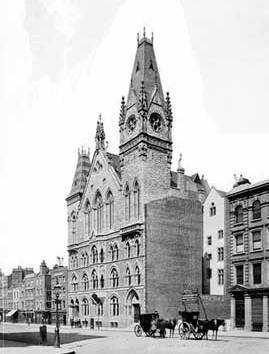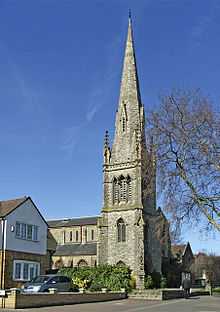John Tarring

John Tarring F.R.I.B.A. (1806–1875) was an English Victorian ecclesiastical architect active in the mid-nineteenth century. Based in London, he designed many Gothic Revival churches for Nonconformist clients.
Life

Tarring was born at Holbeton, near Plymouth, and worked there as a carpenter or plasterer until moving to London in 1828. He studied at Brown's academy in Wells Street, and obtained a Royal Academy medal for a measured drawing. He became a member of the Royal Institute of British Architects in 1845.[2]
Tarring worked principally in London. His firm was variously known as "John Tarring, Esq.," "Tarring & Jones," and "J. Tarring & Son." His son Frederick William Tarring (1847–1925) succeeded him in the business.[3]
Known as the "Gilbert Scott of the Dissenters",[2] he was the first architect to design a spire for a nonconformist church in London, and is thought to have influenced the Baptists and Congregationalists to begin building churches in the Gothic style. Most of his commissions were nonconformist churches, although he had one remodelling commission of an Anglican chapel.
In 1856 he rebuilt George Whitefield's chapel in Tottenham Court Road. The site had recently been bought by the London Congregational Building Society, following the destruction of the existing chapel by fire. Tarring's building had a dome 126 feet (38 m) high. It was closed in 1889 due to subsidence, and later demolished.[4]
Tarring designed at least one church building in Ireland, Trinity Presbyterian Church, Cork, (1861) in a Gothic style with a distinctive spire. The interior has a gallery to the rear with a pipe organ installed there in 1904 and seats for a choir, typical of Roman Catholic churches of the locality, although it may have been intended originally to provide free seating for those unable to afford pew rents; the rest of the interior with a central pulpit, no central aisle and no pillars may reflect Tarring's work on non conformist churches and chapels in the South of England.[5]
Apart from his ecclesiastical work, he restored Combermere Abbey, Cheshire, and Thornton Hall, Buckinghamshire, and designed private residences.[2] At Queen's Gate, Hyde Park, London, in 1860, he built a large mansion block in an Italianate style.[6]
He returned to Devon, and died at Torquay on 27 December 1875.[2]
List of works
Ecclesiastical
- Horbury Congregational Chapel, Kensington Park Road, Notting Hill Gate (1848–9). Closed in 1935 and renamed Kensington Temple, owned first by the Church of the Foursquare Gospel and then by the Elim Pentecostal Church.[7]
- Bethnal Green Meeting House, formerly Pott Street Chapel (1849).
- Congregational Church, Grafton Square, Clapham (1851–2). Demolished.[8]
- St James' Parish church, Akeley, Buckinghamshire (1854; demolished 1982).[9]
- Vines Congregational Church, Rochester, Kent (1854).[10]
- Whitefield's Chapel, Tottenham Court Road (1856).[4]
- Chelsea Congregational Church, Markham Square, Chelsea (1858–60). With a spire 138 feet (42 m) tall. It was designed to accommodate 1,150 adult worshippers, and had schoolrooms attached.[11]
- Trinity Presbyterian Church, Summer Hill, Cork City, Ireland (1860–5).[12]
- Free Church, Market Place, St Ives, Huntingdonshire (1863).[13]
- United Reformed Church, Queens Road, Weybridge, Surrey (1864) [14]
- Former Methodist church, Lady Margaret Road, Hampstead, London (1864–7); now the Roman Catholic Church of Our Lady Help of Christians.[15]
- United Reformed Church, High Street, Lewisham (1867).[16]
- Wesleyan Methodist Church, Mostyn Road, Brixton (1868).[17] Demolished and replaced in the 1980s.[18]
- Southernhay Congregational (now United Reformed)Church, Exeter, Devon (1868). Only the tower and spire of Tarring's church survive; the rest is modern.[19]
- Congregational church, Stamford Hill, London, with adjoining lecture hall (1869–71). Church demolished 1969, lecture hall used for services from then on.[20][21]
- Christ Church, Chase Side, Enfield (1874-7). Congregationalist.[22]
Secular
- Combermere Abbey, Cheshire(restoration).[2]
- Thornton Hall (now Thornton College), Buckinghamshire. Restoration and additions, including a new wing, and a new front to the main building.[23] Tarring's work at Thornton, for the Hon. Richard Cavendish, was begun in 1851.[24]
- Mansion Block, Queen's Gate, Hyde Park, London, in an Italianate style (1860).[6]
References
- ↑ The London Encyclopaedia, Pan Macmillan, 2008, p. 204, ISBN 9781405049245
- ↑ 2.0 2.1 2.2 2.3 2.4
 Lee, Sidney, ed. (1898). "Tarring, John". Dictionary of National Biography 55. London: Smith, Elder & Co.
Lee, Sidney, ed. (1898). "Tarring, John". Dictionary of National Biography 55. London: Smith, Elder & Co. - ↑ Antonia Brodie; British Architectural Library; Royal Institute of British Architects (20 December 2001). Directory of British Architects, 1834-1914: Vol. 2 (L-Z). Continuum International Publishing Group. p. 758. ISBN 978-0-8264-5514-7. Retrieved 2 June 2013.
- ↑ 4.0 4.1 "Tottenham Court Road (west side), Survey of London: volume 21: The parish of St Pancras part 3: Tottenham Court Road & neighbourhood". 1949. pp. 66–74. Retrieved 4 October 2013.
- ↑ Cromie, Alexander Stuart (2004). Presbyterians in the City of Cork. Belfast.
- ↑ 6.0 6.1 "Mansions, Queen's Gate, Hyde Park, London". Archiseek. Retrieved 17 September 2013.
- ↑ "HORBURY CHAPEL, KENSINGTON PARK ROAD, NOTTING HILL GATE, KENSINGTON". AIM25. Retrieved 17 September 2013.
- ↑ Pevsner and Cherry 1990, p.380
- ↑ "Record details". Buckinghamshire County Council. Retrieved 17 September 2013.
- ↑ The Congregational Year Booklocation=London. Jackson and Walford. 1856. p. 258.
- ↑ Bryan, George. Chelsea in the Olden & Present Times. London. pp. 174–5.
- ↑ "Trinity Presbyterian Church, Summer Hill, Cork City". Department of Arts, Heritage and the Gaeltacht. Retrieved 17 September 2013.
- ↑ Historic England. "Details from listed building database (53423)". Images of England.
- ↑ Historic England. "Details from listed building database (286937)". Images of England.
- ↑ Historic England. "Details from listed building database (478634)". Images of England.
- ↑ Pevsner and Cherry 1990, p.417
- ↑ Pevsner and Cherry 1990, p.340
- ↑ "Mostyn Road, Brixton North". Landmark. London Borough of Lambeth. Retrieved 3 October 2013.
- ↑ Historic England. "Details from listed building database (419724)". Images of England.
- ↑ "Congregational church, Stamford Hill, London". Archiseek. Retrieved 17 September 2013.
- ↑ Baker, T.F.T., ed. (1995). A History of the County of Middlesex: Volume 10: Hackney. Victoria County History. pp. 130–144.
- ↑ Historic England. "Details from listed building database (200812)". Images of England.
- ↑ A Series of Executed Examples of Ecclesiastical and Domestic Structures, from the Designs of Modern Architects. London. 1858. p. 14.
- ↑ "Thornton College - formally Thornton Hall". Wolverton and District Archaeological Society. Retrieved 17 September 2013.
Sources
- Cherry, Bridget; Pevsner, Nikolaus (1990) [1983]. London 2: South. The Buildings of England. London: Penguin Books.
- Attribution
![]() This article incorporates text from a publication now in the public domain: Lee, Sidney, ed. (1898). "Tarring, John". Dictionary of National Biography 55. London: Smith, Elder & Co.
This article incorporates text from a publication now in the public domain: Lee, Sidney, ed. (1898). "Tarring, John". Dictionary of National Biography 55. London: Smith, Elder & Co.